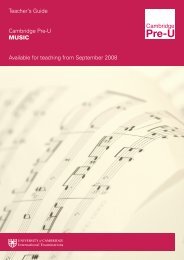Cambridge Pre-U Syllabus - Cambridge International Examinations
Cambridge Pre-U Syllabus - Cambridge International Examinations
Cambridge Pre-U Syllabus - Cambridge International Examinations
Create successful ePaper yourself
Turn your PDF publications into a flip-book with our unique Google optimized e-Paper software.
54<br />
<strong>Cambridge</strong> <strong>Pre</strong>-U Draft<br />
Skill Area Evaluation of procedures and data<br />
Sub-skill<br />
Identifying limitations and sources of error<br />
Candidates should be able to:<br />
• make criticisms of the experimental procedure<br />
• evaluate the effectiveness of control of variables and thus the confidence with which conclusions might<br />
be drawn<br />
• identify the most significant sources of error in an experiment<br />
• estimate, quantitatively, the uncertainty in quantitative measurements<br />
• express such uncertainty in a measurement as an actual or percentage error<br />
• show an understanding of the distinction between systematic errors and random errors<br />
• Identify anomalous values in provided data and suggest appropriate means of dealing with such<br />
anomalies<br />
• Within familiar contexts, suggest possible explanations for anomalous readings<br />
• Identify the extent to which provided readings have been adequately replicated, and describe the<br />
adequacy of the range of data provided<br />
• Use provided information to assess the extent to which selected variables have been effectively<br />
controlled<br />
• Use these evaluations and provided information to make informed judgements on the confidence with<br />
which conclusions may be drawn.<br />
In a table or graph of data, candidates should be able to identify values which are clearly anomalous, and<br />
suggest strategies for dealing with such anomalies, including repeating the experiment or omitting the<br />
affected replicate. Where investigations are set in familiar contexts that candidates are expected to have<br />
explored during the course, candidates may be asked to suggest possible causes for such anomalies (above<br />
and beyond ‘investigator error’), and will be rewarded for answers derived from their own experience of<br />
problems intrinsic in the particular investigation.<br />
Candidates should be used to looking at experiments and assessing the relative importance of errors in<br />
measurement or in making observations so that they can judge which sources of error are most important.<br />
Candidates should be familiar with simple means of estimating error, such as the errors intrinsic in<br />
measuring devices or in the observer’s ability to observe, or in experiments where limitations of the method<br />
introduce errors (e.g. heat loss when trying to assess the energy content of biological materials). They<br />
should be able to express these errors in standard forms such as length = 73 mm ± 1 mm, or temperature<br />
increase = 14 °C ± 4 °C.<br />
Candidates should be able to suggest which of the sources of error described are likely to be systematic<br />
errors such as those resulting from thermometers that consistently read 1 °C above actual temperature, or<br />
candidates who read volumes to the wrong part of the meniscus, as well as those which are likely to be<br />
random errors due to the variability of biological materials, or random variations in environmental conditions<br />
such as room temperature.<br />
For key controlled variables, candidates should be able to give a realistic estimate or appraisal of how<br />
effectively the variable was controlled, for example, how constantly the temperature was maintained across a<br />
number of samples, and from this, give an indication of the confidence that they would have in any<br />
conclusions drawn.

















